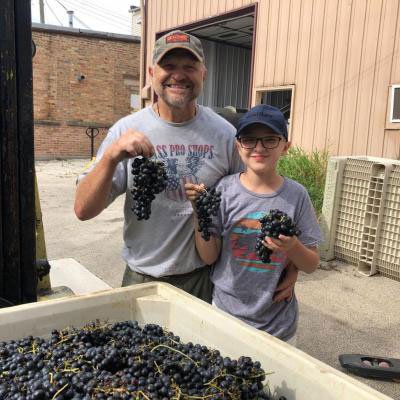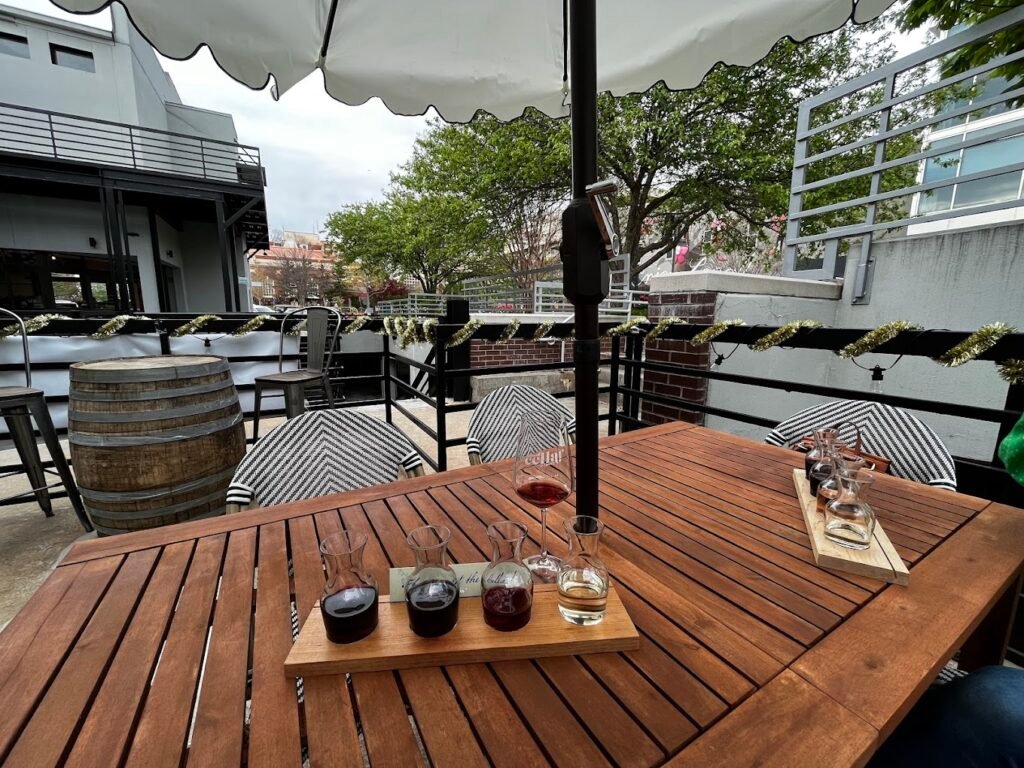
The Pairing Project: State Foods with State Wine – Part 5 of 10

It is hard to believe we are at the halfway point of the state food and wine project. I guess that means the year is half over. Yikes! So far it has been a delicious education in gastronomy, and I haven’t even had one bite of what’s cooking in the east.
The first thing I learned while eating through part 5 was that cheese is dominant. Let’s face it—not many state foods are on the heart-healthy list, but we are entitled to give in to our vices occasionally—even if, due to this project, I’ve been giving in a lot this year!
Illinois

Deep Dish Pizza paired with Prairie State Winery’s Chambourcin ©Darla Hoffmann
Throughout the late 1800s and early 1900s, Neapolitan immigrants arrived in the US, like many Europeans of that time, searching for factory jobs. Before long, Chicago was home to a thriving community of first and second-generation descendants, hungry for the thin pizzas that represented their culture and culinary roots. Eventually, two entrepreneurs, Ike Sewell and Ric Riccardo, decided to create something different: an Italian American version of pizza. In 1943, the pair opened Pizzeria Uno in Chicago’s Near North Side neighborhood, serving a new style of pizza with a deeper dish, crunchier crust, and inverted layers – a far cry from the classic Neapolitan version.
I must admit, I was tempted to purchase a deep dish at Vero Chicago Pizza in my neighborhood. However, I felt the need to take on the task even if it meant the pie would not survive. To my surprise, I found a reasonable recipe for my amateur skills. For the crust, I combined active yeast and sugar in a small bowl and let sit for a minute. In a large bowl, I mixed flour, cornmeal, and salt — then added the yeast mixture, melted butter (slightly cooled? – ok, first time for everything), and canola oil. I stirred until the dough formed, kneaded it into a smooth ball, coated it with olive oil, covered it, and let it sit for one hour. I then stretched the dough over my cast iron, filled it with my desired toppings, and baked it for 30 minutes. And if I say so myself, dem slices were pretty darn tasty.

Harvest at Prairie State Winery ©Prairie State Winery
Prairie State Winery stepped up to the plate for the pairing with their Chambourcin Reserve. The 100% barrel-aged varietal, with scents of bitter chocolate and vanilla, matched the pizza’s fresh bakery aromas. And the wine’s juicy red fruit, stemmy notes and tomato leaf, and hints of tobacco also mingled beautifully with the pizza’s oregano, spicy pepperoni, Italian sausage, garden peppers, and sweet tomato sauce.

Awards at Prairie State ©Prairie State Winery

Making wine at Prairie State Winery ©Prairie State Winery
Prairie State Winery, a unique establishment founded in 1998, was one of the pioneering 16 wineries in Illinois (now there are over 100). What sets it apart is the passion of its owners, Rick and Maria Mamoser, former high school teachers, who pride themselves on crafting the highest-quality wines from 100% Illinois grapes. Their dedication is recognized with 3 Best of Shows, 4 Governor’s Cups, and numerous Best of Class and Gold Medals, a testament to their commitment to excellence.
As you step into Genoa, about 61 miles northeast of Chicago, you’ll be greeted with warm smiles and a friendly welcome from the staff at Prairie State Winery. They invite you to taste their exquisite wines and savor the food made from their private kitchen. And if you visit during the warmer months, you can enjoy their unique music experience in the wine garden events.
Wisconsin

Wisconsin Cheese Curds Prep ©Darla Hoffmann

Cheese Curds paired with Chateau St. Croix’s Itasca ©Darla Hoffmann
When you think of Wisconsin, one of the first things that comes to mind is cheese. The state is known for its dairy production and has a tradition of cheese-making that dates back to the 19th century. And when it comes to cheese, one delicacy stands out above the rest: cheese curds.
Wisconsin’s cheese, produced mainly at small, family-owned and operated cheese factories, is a testament to the cultural tapestry that shaped it. Cheese-making began in Wisconsin around 1840, and settlers from states like New York and Ohio and immigrants from Switzerland and Germany brought their secret recipes to Wisconsin, enriching its cheese-making heritage. As of 2023, Wisconsin produces over 2.8 billion pounds of cheese annually!
Obviously, the dish to make for Wisconsin was a no-brainer: fried cheese curds. I whisked together the flour, beer, milk, eggs, and salt, coated the cheese curds in the batter, and dropped them into hot corn oil until they were golden brown.

Chateau St. Croix in Wisconsin ©Chateau St. Croix

The vineyard at Chateau St. Croix ©Chateau St. Croix
The folks at Chateau St. Croix in St. Croix Falls, Wisconsin, were incredibly hospitable. They kindly sent me some of their wines to determine which would pair best with their state’s favorite food. The crisp white wine made from their local Itasca grapes was the winner. The wine’s soft notes of melon and tropical fruit, firm minerality, and a fresh bite of salinity mellowed the rich, salty cheese, making the pairing a most favorable experience.
Chateau St. Croix Winery is the epitome of down-to-earth Wisconsin. No reservation is needed, and they welcome children and dogs. Their bistro offers fabulous menu items, including flatbreads, sandwiches, and desserts. Call to reserve a tour or private party or attend one of their music events.
Iowa

Corn Au Gratin prep ©Darla Hoffmann

Corn Au Gratin and Chicken Thighs ©Darla Hoffmann
Corn is one of the staple crops of the Hawkeye State and has played a significant role in Iowa’s development and economy. When European settlers arrived in the 1800s, they quickly recognized the fertile soil and ideal climate for growing corn. As a result, corn became a mainstay of Iowa’s agricultural landscape.

Corn Au Gratin paired with Lubben Vineyard’s St. Pepin ©Darla Hoffmann
Today, Iowa is the leading producer of corn in the United States. The crop has various purposes, including animal feed, ethanol production, and human consumption. One delicious way to enjoy corn is in the form of Corn Au Gratin, a creamy and cheesy dish that highlights its natural sweetness.
So, I took a large frying pan, combined onion, bell pepper, flour, and milk, and stirred until thickened. After removing from the heat, I added the corn, cheddar cheese, eggs, sugar, salt, and pepper, poured the mixture into a casserole dish topped with breadcrumbs, and baked for 45 minutes. The fresh-from-the-oven gratin smelled and looked like a version of Thanksgiving Day stuffing.

The folks at Lubben Vineyard in Iowa©Lubben Vineyards
In search of a wine pairing for this corny creation, I reached out to Lubben Vineyards and Wines in the small town of Anamosa, the pumpkin capital of Iowa (another Thanksgiving reference!), east of Cedar Rapids. They sent me their St. Pepin varietal, which immediately proved highly qualified. The fruity white wine with hints of banana and vanilla had the perfect viscosity and sweet honeyed flavors that chimed in tune with the cheesy, vegetal delight.
Lubben Vineyards is a family-owned winery that originated when owners Judy and Dan’s youngest son, who dabbled in brewing beer, talked them into buying a wine kit. After gaining knowledge of Iowa’s terrain and climate and understanding which grapes would thrive in that environment — it was on. Vineyard tours and private events are available for booking. Additionally, Lubben will be a part of the Harvest Host Group next year!
Arkansas

Melting Velvetta ©Darla Hoffmann

Cheese Dip paired with Urban Cellar Chardonnay ©Darla Hoffmann
The story of cheese dip in Arkansas is said to have begun at Little Rock’s Mexico Chiquito restaurant in 1935. Rumor has it that a customer asked for a special order of melted cheese sauce over beef and beans; the rest is history.
Over the years, cheese dip’s popularity spread throughout the state, becoming a staple at parties, festivals, and restaurants. Arkansas even declared cheese dip the official state food in 2005, solidifying its place in the hearts of Arkansans. Whether you prefer it with jalapenos, chorizo, or even bacon, there is a cheese dip for every palate in the Natural State—hence, why the World Cheese Dip Championship is held in Arkansas every year.
I channeled the ‘south wind’ (aka Arkansas) to help make a cheese dip to make the state proud. I tossed a 2-pounder of Velvetta (cut up into chunks), a few cups of grated pepper jack, jalapeno, tomatoes, some milk, a few cans of green chilis, and an Anaheim pepper in the crockpot with some cumin, garlic powder, chili powder, and pepper, let it melt down, and served it with tortilla chips.

Urban Cellar Winery flights ©Urban Cellar

Tasting Room at Urban Cellar Winery ©Urban Cellar
Urban Cellar Winery in Fayetteville graciously sent their 2022 Chardonnay for the wine pairing. The wine’s slight oak gave it hints of pie crust and sweet corn and a viscous mouthfeel that matched the creaminess of the dip. Additionally, the Chardonnay’s vegetal spice and subtle minerality complemented the peppery, salty flavors in the cheese and chips.

Patio at Urban Cellar Winery ©Urban Cellar
Cassidy Ginger, founder of Urban Cellar, offers wine-making workshops and events in her tasting bar in the heart of Fayetteville on the historic square. The space is a neighborhood winery, gift shop, and a place for patrons to partake in interactive wine experiences, including bottling, blending, and labeling. Recent renovations have been exciting for the team at Urban Cellar, and they welcome you to join in on the fun.
Indiana

Breading the Pork ©Darla Hoffmann

BPT sandwiches paired with Running Vines Winery’s Pinot Noir ©Darla Hoffmann
The history behind the oversized pork tenderloin sandwich dates to the early 1900s. It is said that a man named Nick Freienstein, born to German immigrant parents, had a food cart selling burgers and, now called BPTs: Breaded Pork Tenderloin Sandwiches. The cart gained quite the following and eventually became a restaurant spot called Nick’s Kitchen, which still exists today in Huntington, Indiana, famous for Hoosiers’ original BPT.
Like a German Schnitzel dish, I pounded the pork flat to tenderize, breaded the meat, and lowered the cutlets into a hot frying pan of peanut oil. Once golden brown, I transferred the cutlets to a fresh Kaiser roll and topped the sandwich with ketchup, lettuce, and pickles—it was a very Midwestern delight.

Tasting Room at Running Vines Winery ©Running Vines
I was drawn to Running Vines Winery to make the pairing as my personal love of running and wine intrigued me to a tasting. Their slightly oaked Pinot Noir with notes of coconut, baked cherries, and fresh raspberries balanced the juicy, sharp, salty pork creation.

Flights at Running Vines Winery in Indiana ©Running Vines
Running Vines Winery is a true family affair owned and operated by Veteran Nicki Caylor and her son, Luke. Their strong sense of community and passion for wine and running create a special vibe in their tasting room in Chesterton, Indiana. Nicki’s Italian roots interested her in wine from an early age, and she has always treasured sharing it with friends and family. Join them and become a part of their extended family, and indulge in pizzas, salads, beer, cocktails, seasonal ciders, and, of course, wine.

25 States down, Part 5 ©Darla Hoffmann
Well, now that we’ve completed half the journey there’s no stopping me. I am committed to eating and drinking until I reach the states along the Atlantic – I hope you will continue to follow along. 25 states down, 25 to go!


































